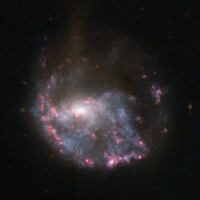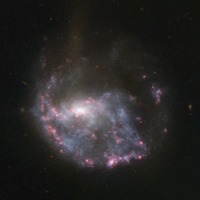Hubble Sees a Galaxy Hit a Bull's-Eye
Dublin Core
Title
Subject
Description
Bright pink nebulae almost completely encircle a spiral galaxy in this NASA/ESA Hubble Space Telescope image of NGC 922. The ring structure and the galaxy's distorted spiral shape result from a smaller galaxy scoring a cosmic bull's-eye, hitting the center of NGC 922 some 330 million years ago.
NGC 922's current unusual form is the result of a cosmic collision with a smaller galaxy named 2MASXI J0224301-244443, which plunged right through the heart of NGC 922 and shot out the other side. As the smaller galaxy passed through the middle of NGC 922, it set up gravitational ripples that disrupted the clouds of gas and triggered the formation of new stars whose radiation then lit up the remaining gas. The bright pink color of the resulting nebulae is a characteristic sign of this process and is emitted by excited hydrogen gas (the dominant element in interstellar gas clouds).
Hubble's image of NGC 922 consists of a series of exposures taken in visible light with the Wide Field Camera 3, and in visible and near-infrared light with the Wide Field and Planetary Camera 2. NGC 922 lies 157 million light-years away from Earth.

